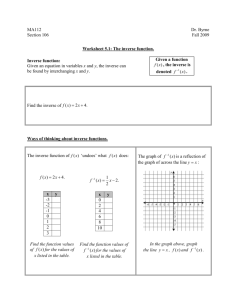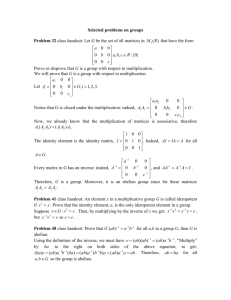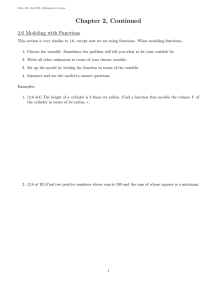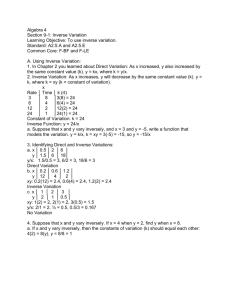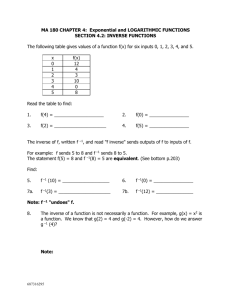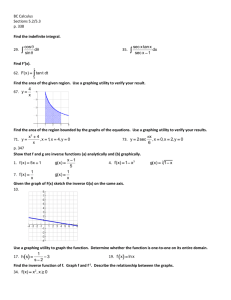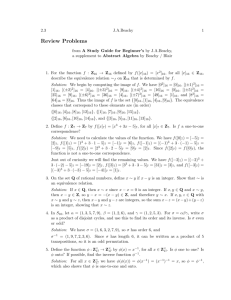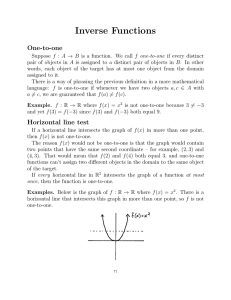Section 2.7: Function Arithmetic, Composition Functions can be
advertisement
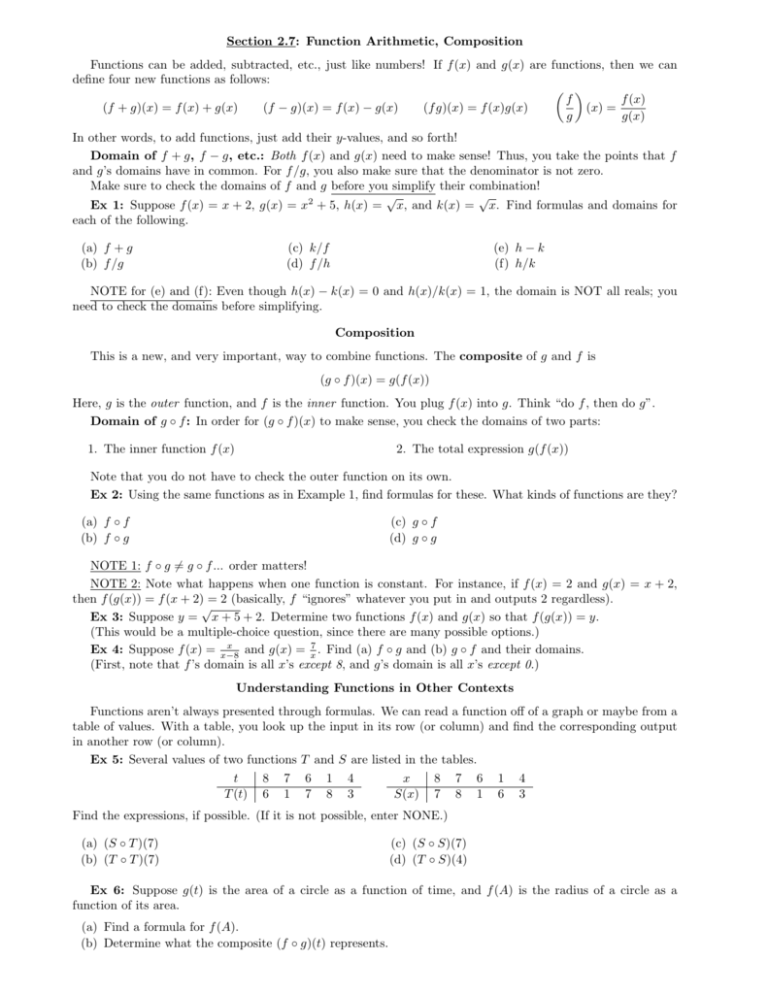
Section 2.7: Function Arithmetic, Composition Functions can be added, subtracted, etc., just like numbers! If f (x) and g(x) are functions, then we can define four new functions as follows: f f (x) (f + g)(x) = f (x) + g(x) (f − g)(x) = f (x) − g(x) (f g)(x) = f (x)g(x) (x) = g g(x) In other words, to add functions, just add their y-values, and so forth! Domain of f + g, f − g, etc.: Both f (x) and g(x) need to make sense! Thus, you take the points that f and g’s domains have in common. For f /g, you also make sure that the denominator is not zero. Make sure to check the domains of f and g before you simplify their combination! √ √ Ex 1: Suppose f (x) = x + 2, g(x) = x2 + 5, h(x) = x, and k(x) = x. Find formulas and domains for each of the following. (a) f + g (b) f /g (e) h − k (f) h/k (c) k/f (d) f /h NOTE for (e) and (f): Even though h(x) − k(x) = 0 and h(x)/k(x) = 1, the domain is NOT all reals; you need to check the domains before simplifying. Composition This is a new, and very important, way to combine functions. The composite of g and f is (g ◦ f )(x) = g(f (x)) Here, g is the outer function, and f is the inner function. You plug f (x) into g. Think “do f , then do g”. Domain of g ◦ f : In order for (g ◦ f )(x) to make sense, you check the domains of two parts: 1. The inner function f (x) 2. The total expression g(f (x)) Note that you do not have to check the outer function on its own. Ex 2: Using the same functions as in Example 1, find formulas for these. What kinds of functions are they? (a) f ◦ f (b) f ◦ g (c) g ◦ f (d) g ◦ g NOTE 1: f ◦ g 6= g ◦ f ... order matters! NOTE 2: Note what happens when one function is constant. For instance, if f (x) = 2 and g(x) = x + 2, then f (g(x)) = f (x + 2) = 2 (basically, f “ignores” whatever you put in and outputs 2 regardless). √ Ex 3: Suppose y = x + 5 + 2. Determine two functions f (x) and g(x) so that f (g(x)) = y. (This would be a multiple-choice question, since there are many possible options.) x Ex 4: Suppose f (x) = x−8 and g(x) = x7 . Find (a) f ◦ g and (b) g ◦ f and their domains. (First, note that f ’s domain is all x’s except 8, and g’s domain is all x’s except 0.) Understanding Functions in Other Contexts Functions aren’t always presented through formulas. We can read a function off of a graph or maybe from a table of values. With a table, you look up the input in its row (or column) and find the corresponding output in another row (or column). Ex 5: Several values of two functions T and S are listed in the tables. t 8 7 6 1 4 x 8 7 6 1 4 T (t) 6 1 7 8 3 S(x) 7 8 1 6 3 Find the expressions, if possible. (If it is not possible, enter NONE.) (a) (S ◦ T )(7) (b) (T ◦ T )(7) (c) (S ◦ S)(7) (d) (T ◦ S)(4) Ex 6: Suppose g(t) is the area of a circle as a function of time, and f (A) is the radius of a circle as a function of its area. (a) Find a formula for f (A). (b) Determine what the composite (f ◦ g)(t) represents. Section 4.1: Inverse Functions Recall a function’s graph passes the Vertical Line Test, meaning no vertical line strikes twice. (i.e. Each x coordinate can only produce one y.) There is a similar Horizontal Line Test, saying that no horizontal line strikes twice. (Hence, each y coordinate only comes from one x.) A function passing the Horizontal Line Test is called one-to-one or invertible. REMARK: Another way of saying y = f (x) is one-to-one is to say that when you solve for x, you don’t get multiple solutions. Ex 7: Is the function f (x) = 6x − 1 one-to-one? What about g(x) = (x + 3)2 − 4? If f is invertible, then the inverse function f −1 is the function that swaps the roles of input and output. Therefore, y = f (x) ⇐⇒ x = f −1 (y) In other words, (a, b) is on f ’s graph iff (b, a) is on f −1 ’s graph. Computing f −1 (a): Think about working backwards... which value of x makes f (x) = a? Sample: If f (1) = 3 and f is invertible, then f −1 (3) = 1. (i.e. “f sends 1 to 3, so f −1 sends 3 back to 1!”) Sample 2: If A = f (x) computes the area of a square as a function of side length x, then x = f −1 (A) computes the side length as a function of area. Ex 8: Using the tables from Example 5, find the expressions, if possible. (a) T −1 (1) (b) S −1 (4) (c) T −1 (S(7)) (d) S(S −1 (3)) NOTE: f −1 does not mean the same thing as f to the −1 power... it is not 1/f . Important Properties of f −1 • Theorem of Inverse Functions: f and f −1 cancel each other when you compose either way. f (f −1 (x)) = x and f −1 (f (x)) = x • The graph of y = f −1 (x) is obtained by reflecting the graph of y = f (x) over the diagonal line y = x. • When inverting, domain and range switch! Thus, the domain of f is the range of f −1 and vice versa. Ex 9: The graph of a one-to-one function f is provided. (The labeled points are (0, 4) and (12, −4).) (a) Sketch a graph of f −1 . NOTE: If you draw both graphs and tilt your paper (or your head) appropriately, you should see that the two graphs are mirror images over y = x. (b) Find the domain and range of f . (c) Find the domain and range of f −1 . Recall our work with transforming a point on a graph. We can do the same with inverses! The key thing is: if (a, b) is a point on y = f (x), then when using the inverse, start instead with (b, a). (Switch the coordinates!) Ex 10: Suppose (a, b) is on the graph of y = f (x). Find the corresponding point on: (a) y = f −1 (x) (b) y = 2f −1 (x − 1) + 1 Computing f −1 To find the inverse of y = f (x), solve x in terms of y. At the end, you’ll have x = f −1 (y). If needed, you then switch the variables names to get y = f −1 (x). (I do this LAST.) Ex 11: For each function, compute the inverse function f −1 (x). (a) f (x) = 2x + 1 (b) f (x) = x2 + 1 where x ≤ 0 (c) f (x) = 3x3 − 1 x+5 (d) f (x) = 2x−1
